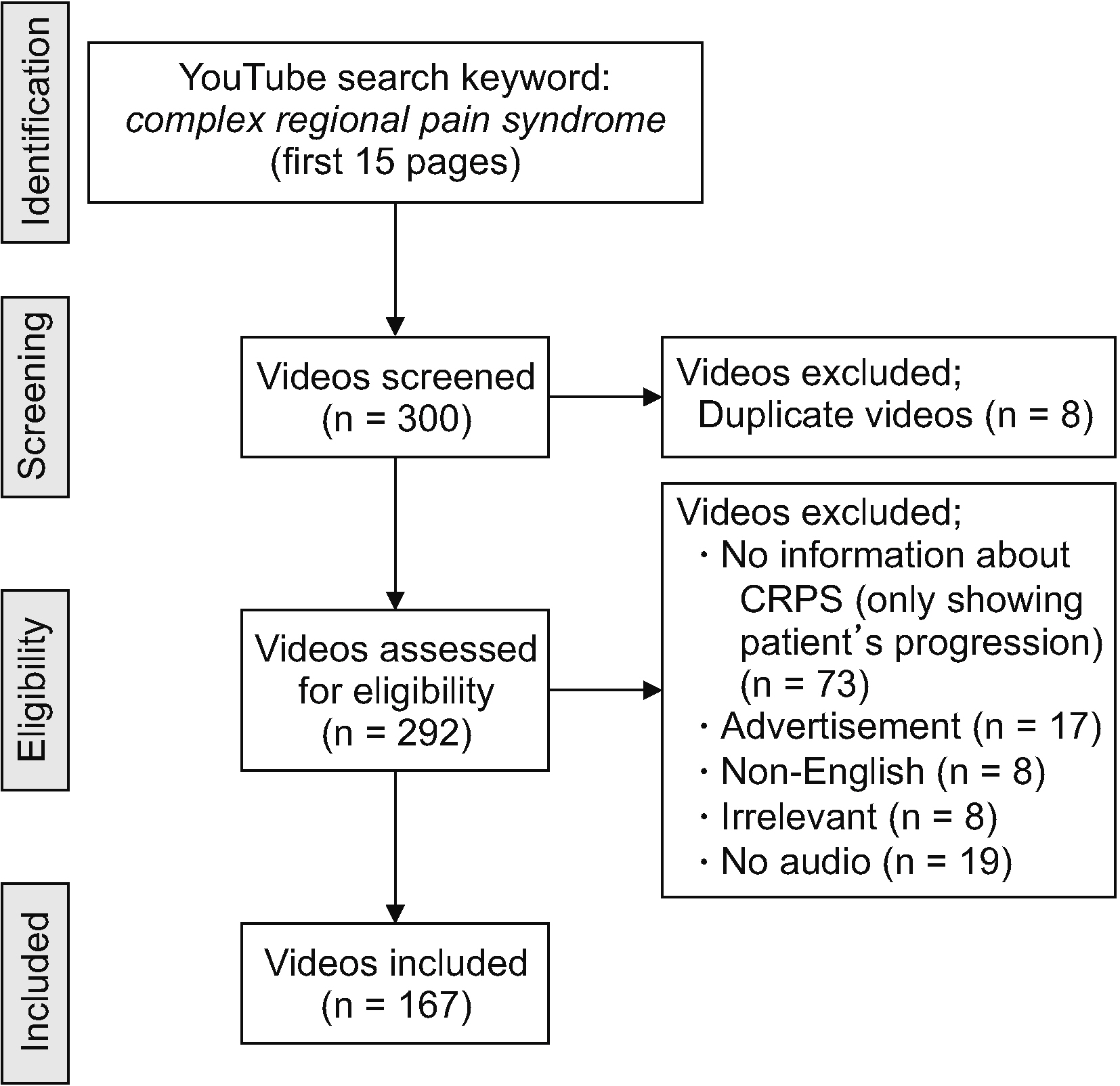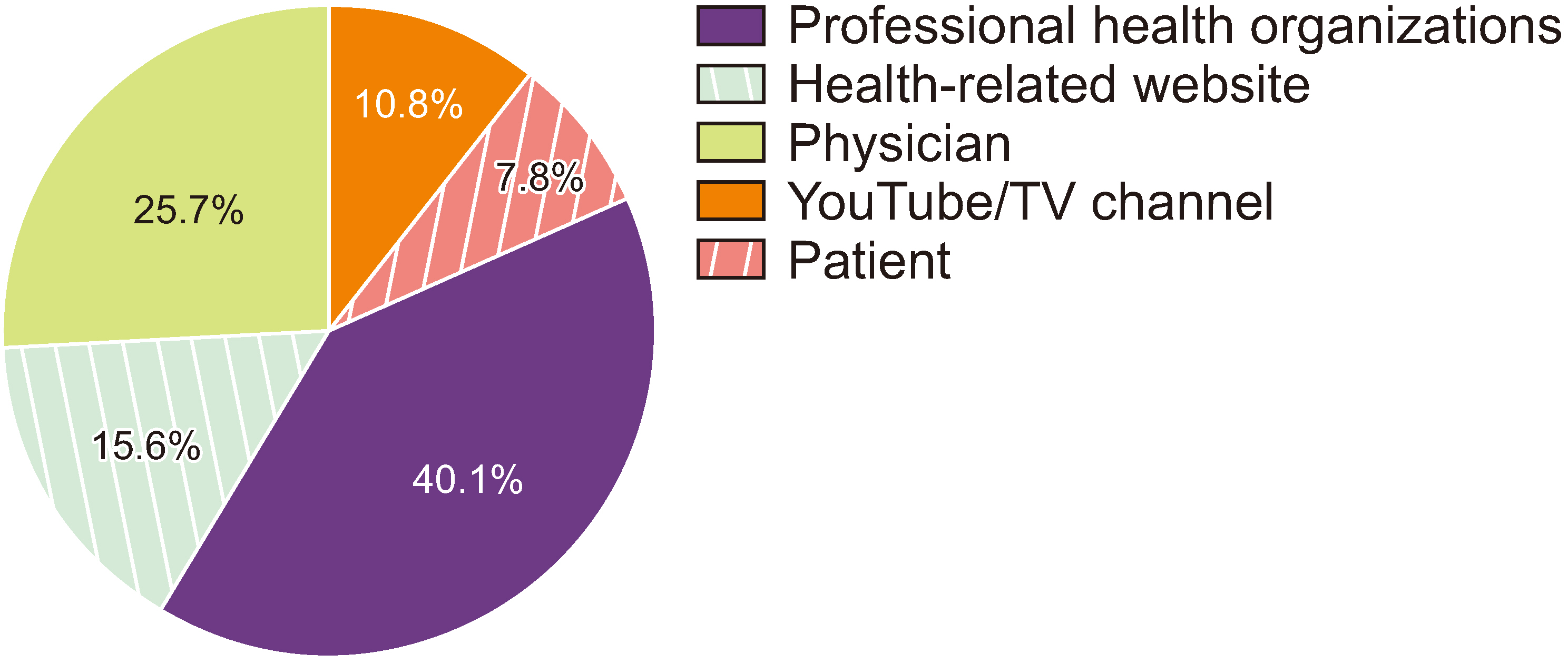Korean J Pain.
2022 Jul;35(3):319-326. 10.3344/kjp.2022.35.3.319.
Evaluation of YouTube videos as sources of information about complex regional pain syndrome
- Affiliations
-
- 1Department of Physical Medicine and Rehabilitation, Katip Celebi University, Faculty of Medicine, Izmir, Turkey
- KMID: 2530987
- DOI: http://doi.org/10.3344/kjp.2022.35.3.319
Abstract
- Background
As the internet usage becomes easily accessible, the patients are more frequently searching about diseases and medical/non-medical treatments. Considering that complex regional pain syndrome (CRPS) is a debilitating disease, it is important to check the information that patients are accessing. Therefore, this study aimed to investigate the reliability, sufficiency, and accuracy of the YouTube videos about CRPS.
Methods
This study is a descriptive research which is derived by searching videos using the keyword ‘complex regional pain syndrome’ on YouTube. Relevancebased sequencing was used to sort the videos. Sources and video parameters were documented. To evaluate the accuracy, reliability and content quality of the videos, Global Quality Score, Journal of American Medical Association Benchmark Criteria and Modified DISCERN Questionnaire scales were used.
Results
A total of 167 videos were included in this study. The majority of the videos originated from USA (80.2%, n = 134). The median number of views was 639 and the viewing rate was 73.3. Most of the videos had partially sufficient data and the interaction index viewing rate parameters for videos with high content quality were greater than videos with low content quality (P = 0.010, P = 0.014).
Conclusions
Our results showed that videos about CRPS on YouTube mostly had partially sufficient data and include intermediate-high quality contents. Moreover, high-content quality videos had higher viewing rates, interaction indexes, number of likes, longer durations, as well as better reliability and accuracy scores. Videos with high quality and reliable content are needed to reduce misinformation about CRPS.
Keyword
Figure
Reference
-
1. Urits I, Shen AH, Jones MR, Viswanath O, Kaye AD. 2018; Complex regional pain syndrome, current concepts and treatment options. Curr Pain Headache Rep. 22:10. DOI: 10.1007/s11916-018-0667-7. PMID: 29404787.
Article2. Bruehl S. 2015; Complex regional pain syndrome. BMJ. 351:h2730. DOI: 10.1136/bmj.h2730. PMID: 26224572. PMCID: PMC8388269.
Article3. Neumeister MW, Romanelli MR. 2020; Complex regional pain syndrome. Clin Plast Surg. 47:305–10. DOI: 10.1016/j.cps.2019.12.009. PMID: 32115056.
Article4. Shim H, Rose J, Halle S, Shekane P. 2019; Complex regional pain syndrome: a narrative review for the practising clinician. Br J Anaesth. 123:e424–33. DOI: 10.1016/j.bja.2019.03.030. PMID: 31056241. PMCID: PMC6676230.
Article5. de Mos M, de Bruijn AG, Huygen FJ, Dieleman JP, Stricker BH, Sturkenboom MC. 2007; The incidence of complex regional pain syndrome: a population-based study. Pain. 129:12–20. DOI: 10.1016/j.pain.2006.09.008. PMID: 17084977.
Article6. Misidou C, Papagoras C. 2019; Complex regional pain syndrome: an update. Mediterr J Rheumatol. 30:16–25. DOI: 10.31138/mjr.30.1.16. PMID: 32185338. PMCID: PMC7045919. PMID: 9e526554f122407e86fee8ba3e5b1598.
Article7. Chang C, McDonnell P, Gershwin ME. 2019; Complex regional pain syndrome - false hopes and miscommunications. Autoimmun Rev. 18:270–8. DOI: 10.1016/j.autrev.2018.10.003. PMID: 30639650.
Article8. Sandroni P, Benrud-Larson LM, McClelland RL, Low PA. 2003; Complex regional pain syndrome type I: incidence and prevalence in Olmsted county, a population-based study. Pain. 103:199–207. DOI: 10.1016/S0304-3959(03)00065-4. PMID: 12749974.
Article9. Elsharydah A, Loo NH, Minhajuddin A, Kandil ES. 2017; Complex regional pain syndrome type 1 predictors - epidemiological perspective from a national database analysis. J Clin Anesth. 39:34–7. DOI: 10.1016/j.jclinane.2017.03.027. PMID: 28494904.
Article10. van Velzen GAJ, Perez RSGM, van Gestel MA, Huygen FJPM, van Kleef M, van Eijs F, et al. 2014; Health-related quality of life in 975 patients with complex regional pain syndrome type 1. Pain. 155:629–34. DOI: 10.1016/j.pain.2013.12.017. PMID: 24342465.
Article11. Jeong S, An J, Cho S. 2021; Role of affective instability on suicidal risk in complex regional pain syndrome: a diary approach (preliminary report). Korean J Pain. 34:94–105. DOI: 10.3344/kjp.2021.34.1.94. PMID: 33380572. PMCID: PMC7783859.
Article12. Eldufani J, Elahmer N, Blaise G. 2020; A medical mystery of complex regional pain syndrome. Heliyon. 6:e03329. DOI: 10.1016/j.heliyon.2020.e03329. PMID: 32149194. PMCID: PMC7033333.
Article13. Iolascon G, Moretti A. 2019; Pharmacotherapeutic options for complex regional pain syndrome. Expert Opin Pharmacother. 20:1377–86. DOI: 10.1080/14656566.2019.1612367. PMID: 31063415.
Article14. Statista. 2021. Most popular websites worldwide as of November 2021, by total visits (in billions). [Internet]. Statista Inc.;New York (NY): Available at: https://www.statista.com/statistics/1201880/most-visited-websites-worldwide/.15. Bernard A, Langille M, Hughes S, Rose C, Leddin D, Veldhuyzen van Zanten S. 2007; A systematic review of patient inflammatory bowel disease information resources on the World Wide Web. Am J Gastroenterol. 102:2070–7. DOI: 10.1111/j.1572-0241.2007.01325.x. PMID: 17511753.
Article16. Silberg WM, Lundberg GD, Musacchio RA. 1997; Assessing, controlling, and assuring the quality of medical information on the Internet: caveant lector et viewor--let the reader and viewer beware. JAMA. 277:1244–5. DOI: 10.1001/jama.1997.03540390074039. PMID: 9103351.
Article17. Singh AG, Singh S, Singh PP. 2012; YouTube for information on rheumatoid arthritis--a wakeup call? J Rheumatol. 39:899–903. DOI: 10.3899/jrheum.111114. PMID: 22467934.
Article18. Charnock D, Shepperd S, Needham G, Gann R. 1999; DISCERN: an instrument for judging the quality of written consumer health information on treatment choices. J Epidemiol Community Health. 53:105–11. DOI: 10.1136/jech.53.2.105. PMID: 10396471. PMCID: PMC1756830.
Article19. Goobie GC, Guler SA, Johannson KA, Fisher JH, Ryerson CJ. 2019; YouTube videos as a source of misinformation on idiopathic pulmonary fibrosis. Ann Am Thorac Soc. 16:572–9. DOI: 10.1513/AnnalsATS.201809-644OC. PMID: 30608877.
Article20. Lee JS, Seo HS, Hong TH. 2014; YouTube as a source of patient information on gallstone disease. World J Gastroenterol. 20:4066–70. DOI: 10.3748/wjg.v20.i14.4066. PMID: 24744597. PMCID: PMC3983464.
Article21. Keelan J, Pavri-Garcia V, Tomlinson G, Wilson K. 2007; YouTube as a source of information on immunization: a content analysis. JAMA. 298:2482–4. DOI: 10.1001/jama.298.21.2482. PMID: 18056901.
Article22. Stamelou M, Edwards MJ, Espay AJ, Fung VS, Hallett M, Lang AE, et al. 2011; Movement disorders on YouTube--caveat spectator. N Engl J Med. 365:1160–1. DOI: 10.1056/NEJMc1107673. PMID: 21992142. PMCID: PMC4230337.23. Kumar N, Pandey A, Venkatraman A, Garg N. 2014; Are video sharing web sites a useful source of information on hypertension? J Am Soc Hypertens. 8:481–90. DOI: 10.1016/j.jash.2014.05.001. PMID: 25064770.
Article24. Tajerian M, Clark JD. 2016; New concepts in complex regional pain syndrome. Hand Clin. 32:41–9. DOI: 10.1016/j.hcl.2015.08.003. PMID: 26611388. PMCID: PMC4662772.
Article25. Williams G, Howard R. 2016; The pharmacological management of complex regional pain syndrome in pediatric patients. Paediatr Drugs. 18:243–50. DOI: 10.1007/s40272-016-0179-z. PMID: 27194166.
Article26. Ranade AS, Belthur MV, Oka GA, Malone JD. 2020; YouTube as an information source for clubfoot: a quality analysis of video content. J Pediatr Orthop B. 29:375–8. DOI: 10.1097/BPB.0000000000000694. PMID: 31725533.
Article27. Gonzalez-Estrada A, Cuervo-Pardo L, Ghosh B, Smith M, Pazheri F, Zell K, et al. 2015; Popular on YouTube: a critical appraisal of the educational quality of information regarding asthma. Allergy Asthma Proc. 36:e121–6. DOI: 10.2500/aap.2015.36.3890. PMID: 26534743.
Article28. Koller U, Waldstein W, Schatz KD, Windhager R. 2016; YouTube provides irrelevant information for the diagnosis and treatment of hip arthritis. Int Orthop. 40:1995–2002. DOI: 10.1007/s00264-016-3174-7. PMID: 27029480.
Article29. Lee KN, Son GH, Park SH, Kim Y, Park ST. 2020; YouTube as a source of information and education on hysterectomy. J Korean Med Sci. 35:e196. DOI: 10.3346/jkms.2020.35.e196. PMID: 32597042. PMCID: PMC7324264.
Article30. Şahin A, Şahin M, Türkcü FM. 2019; YouTube as a source of information in retinopathy of prematurity. Ir J Med Sci. 188:613–7. DOI: 10.1007/s11845-018-1902-2. PMID: 30238185.
Article31. Tolu S, Yurdakul OV, Basaran B, Rezvani A. 2018; English-language videos on YouTube as a source of information on self-administer subcutaneous anti-tumour necrosis factor agent injections. Rheumatol Int. 38:1285–92. DOI: 10.1007/s00296-018-4047-8. PMID: 29761222.
Article32. Sood A, Sarangi S, Pandey A, Murugiah K. 2011; YouTube as a source of information on kidney stone disease. Urology. 77:558–62. DOI: 10.1016/j.urology.2010.07.536. PMID: 21131027.
Article
- Full Text Links
- Actions
-
Cited
- CITED
-
- Close
- Share
- Similar articles
-
- Evaluation of YouTube Videos on Hepatocellular Carcinoma
- Evaluation of the reliability and information quality of YouTube videos on implant overdenture
- Evaluation of YouTube Videos Regarding Clean Intermittent Catheterization Application
- YouTube as an Information Resource for Persons Interested in Septoplasty and/or Turbinoplasty
- YouTube as a source of information about rubber dam: quality and content analysis



